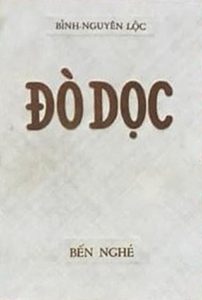Bình Nguyên Lộc’s Thoroughfare (Đò dọc, 1959) is a charming novel about migration and dislocation in southern Vietnam in the mid-1950s. Nam Thành and his wife are originally from a village in Bạc Liêu province in the Mekong delta, but they flee with their daughters to Saigon during the early years of the Resistance War (Kháng Chiến Chống Pháp, 1945-1954), Vietnam’s war of independence from France. The same conflict is known in the West as First Indochina War (1946-1954) with a slightly different starting point. Adrift in the city, Nam Thành manages to provide for his family by selling luggage to French soldiers, and business grows brisk when the war ends and more and more foreign troops leave with the withdrawal of the French Expeditionary Corps – that is, around 1954-1956.
Yet the departure of such reliable customers also spells trouble for the family. As money dries up, Nam Thành finds that he cannot earn enough to keep up with the high costs in Saigon. His solution is to move the family to the village of Linh Chiểu, located near Thủ Đức, just east of the capital city. But the move itself creates more difficulties for the family. Of his four daughters, all but the eldest grew up entirely in Saigon, and they dread leaving behind the delights of the city for a sleepy little village. More seriously, none of the daughters have attracted any offers of marriage, and moving to a strange place will make it even harder for the girls to find husbands. The daughters have not received enough schooling to find well-paying employment and live as independent women. Surveying the situation, the aging Nam Thành and his wife worry about their ability to support their girls indefinitely.

The set up is reminiscent of Jane Austen’s Pride and Prejudice, but whereas Austen’s novel dramatizes the economic precarity and constrained choices of women in the lowest rungs of the English gentry, Bình Nguyên Lộc uses the plight of the unmarried daughters to dramatize the sense of dislocation and uncertainty experienced by migrants. The daughters do not know if they will even enjoy the security and stability of marriage just as the family does not know if it will ever have a permanent home. The family’s transitory existence ruptured the parents’ social connections, connections that they would otherwise draw on to find spouses for their girls. It also strains the daughter’s friendships, friendships through which they might meet eligible young men. Finding themselves in yet another new place, Nam Thành and his wife are nostalgic for the rustic simplicity of their village in prewar Bạc Liêu while their daughters long for the excitement and attractions of Saigon. Suddenly, hope comes in the form of a handsome young visitor…
The novel offers a sweet portrayal of a happy family. Although buffeted by war and economic dislocations, their anxious lives are soothed in part by their love for each other and sense of humor. The parents are committed to doing the best for their daughters, even if they aren’t always sure how. The girls manage to laugh at almost everything around them despite their plight. They poke fun at each other, their parents, and their neighbors, and the dialogue in the book is just hilarious. Yet the humor is always gentle, never biting. Bình Nguyên Lộc wants the reader to laugh with the characters, and he presents them as well-meaning human beings who are full of foibles. Sometimes, the author also invites us to laugh at the characters. He intentionally incorporates clichés that were popular in Vietnamese romance novels, such as the figure of the handsome, sensitive artist and the lovesick young person who is ready to commit suicide in the face of romantic disappointment. He aims to make fun of romance novels while also entertaining the reader with the characters’ romantic adventures.
I found myself impressed by Bình Nguyên Lộc’s sensitive portrayal of the daughters’ plight. Unlike in some other books written by men at the time, the female characters have distinctive personalities in their own right and are never two-dimensional stock characters defined by the men around them. They have their own desires and quirky personalities despite their very conventional longing for romance and marriage. In a key scene, the youngest daughter receives a visit from a prospective spouse and his parents, and the author emphasizes her indignity and discomfort at being sized up by strangers. But she is no shrinking violet, and she tells the young man exactly what she thinks of the situation.
The novel offers a counterpart to the many, many narratives about the migration of northerners to the south in 1954-1955 at the end of the Resistance War. It was this better-known north-south migration that dominated literature in the early RVN, much of it written by northern émigré authors in a decidedly northern dialect. In contrast, Thoroughfare focuses on southerners who migrated within the south and is written in a distinctively southern accent. Bình Nguyên Lộc is what might be described as a southern regionalist writer. He chose to write in the southern dialect and devoted much of his fiction to exploring the experiences of southerners. In fact, his nom de plume is a playful Sino-Vietnamese rendering of Đồng Nai, an old name for southeastern Vietnam (Đồng = Bình Nguyên, Nai = Lộc). The title of the novel is meant to evoke the long journeys of southern migrants. Southern Vietnam is crisscrossed by rivers and canals, and đò dọc, literally meaning “vertical ferry,” refers to long-distance ferries that carried passengers up or downstream along the north-south axis, as distinct from short-distance “horizontal ferries” that took passengers across a waterway along the east-west axis. Nam Thành and his family have left their home for good, and their wandering is akin to the vertical rather than the horizontal ferry. Specifically, the author describes the family’s new home in Linh Chiểu as being on the route betwee Saigon and the city of Biên Hòa and describes this route as a đò dọc. Vehicles drive pass the village on the way to somewhere else but have no reason to stop, just as a long-distance ferry may travel down a river without docking anywhere. As exiles in this seemingly forgotten corner of the countryside, the daughters watch the traffic pass and feel like life is passing them by as well. I have translated đò dọc as thoroughfare to capture this sense of a neglected place that one passes through but does not visit, similar to the American expression flyover country.
I found the novel’s exploration of multi-generational migration to be very poignant because it speaks to the experiences of countless Vietnamese families, including my own. I belong to what might be described as the third generation of migrants in my family. My grandparents came of age in the countryside on opposite ends of the country but migrated to Saigon and made a new life for themselves there starting in the 1940s. My parents grew up in the capital of the Republic of Vietnam but fled to America some years after the end of the Vietnam War. My sibling and I have long left our American hometown for jobs elsewhere in the US. Like Nam Thành and his family, I wonder if we will ever be able to stay put.
THE TECHNICAL STUFF
Note for readers: Bình Nguyên Lộc’s Thoroughfare is available as a free Vietnamese-language audio book, and the first installment can be found here: https://www.youtube.com/watch?v=e8QzD68o97E.
Note for researchers: This novel won the national literary prize of the Republic of Vietnam in 1960. The book would be great for scholars interested in migration, rural life, courtship and marriage customs, and southern regionalism within Vietnamese literature.
The version I read: Bình Nguyên Lộc. Đò dọc. Reprint ed. Lancaster, PA: Xuân Thu, [1981?].

